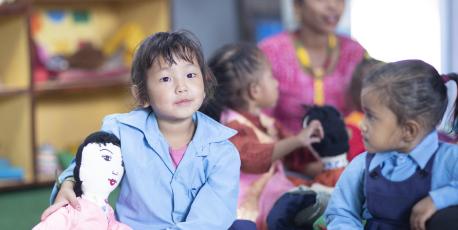
LET US LEARN NEPAL: MULTIPLE PATHWAYS TO LEARNING
In Nepal, UNICEF's Let Us Learn program reaches vulnerable children in 15 of the most disadvantaged districts in the country. Nationwide lockdowns due to COVID-19 rendered the work of Let Us Learn even more critical to preserving these children’s futures.
Over 450,000 people have benefitted since the program started in 2011.
The situation for children and education in Nepal
In Nepal, education and learning outcomes are directly linked to children’s gender, socio-economic status, physical and mental ability, geographic location and ethnicity. For girs, isolation during menstruation and early marriage are major barriers. Nepal’s early marriage rate is one of the highest in Asia, and married girls in Nepal are ten times more likely to be out of school compared to their unmarried peers.
High student-teacher ratios also contribute to poor learning outcomes, low attendance and high dropout rates.
In addition to social and cultural barriers, children in Nepal are frequently forced out of school as a result of natural disasters. Earthquakes are common in the Himalayan mountains, and Nepal is especially susceptible. In recent years, children have also had their education interrupted by flooding, landslides and political turmoil in the country.
Responding to COVID-19 lockdowns, the Nepal government rolled out remote learning packages on digital platforms, radio, TV and as printed materials for students. Although children were able to access remote learning through these packages, a nationwide survey found that only 30 percent of children were participating in remote learning. Families — already burdened with the pressures of the pandemic — struggled to find the time to home school their children or were otherwise ill equipped to assume the role of teacher. For some families, education has been deprioritized in favor of generating income to fund basic needs.
UNICEF in Nepal helping children get back to learning
Let Us Learn Nepal has three pillars:
Early childhood development: UNICEF provides children up to age 5 with quality education by training instructors, supplying learning materials and resources and helping local governments monitor program quality
Early grade learning: UNICEF helps students ages 5 to 9 who are at risk of dropping out by providing learning materials for non-Nepali speakers in their native language, community-based education groups and specialized learning pathways for children with disabilities
Girl’s access to education: UNICEF supports out-of-school girls ages 8 to 15, with a nine-month accelerated learning program to catch up on education they missed during their primary school years. After completing the program students are integrated back into formal, mainstream education. UNICEF also supports students with homework clubs and other learning opportunities.
Through Let Us Learn, UNICEF Nepal also arranges for teachers from the accelerated program to be redeployed as assistants at schools that are short staffed.
As COVID restrictions lift, UNICEF and partners are working to safely scale work across the three pillars through:
non-formal education programs for out-of-school and marginalized children
remedial after-school programs for children who continued schooling during the pandemic but at a decelerated rate
Learning Circles for learners who need more individualized support, including children with disabilities
Learn more about Let Us Learn in other countries.
Top photo: Young children learn at a UNICEF-supported, non-formal early childhood education center at Samajkalyan Primary School at Kavrepalanchowk District in Nepal. ©UNICEF/UNI222583/Prasad Ngakhusi